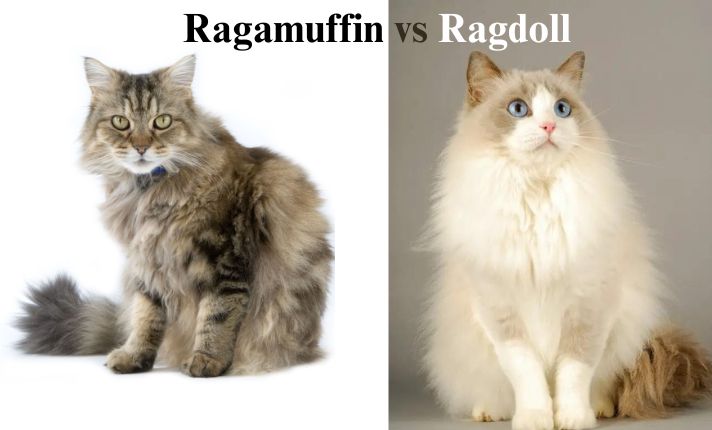Are you torn between adopting a Ragamuffin or a Ragdoll cat? At first glance, these two fluffy breeds may look quite similar, but each has distinct characteristics that set them apart. Whether looking for a playful, friendly cat or a calm, docile companion, understanding the unique qualities of Ragamuffin and Ragdoll cats will help you choose the best feline friend for your lifestyle.
The key difference lies in their appearance—Ragamuffins come in a wider variety of coat colors and patterns, including solids, tortoiseshell, and tabby. At the same time, Ragdolls are known for their signature pointed color pattern, which means their face, ears, legs, and tail are darker than the rest of their body. This distinction in coat coloring is one of the most noticeable differences between the two breeds.
Visual Differences
Here’s a quick comparison table between Ragamuffins and Ragdolls:
| Feature | Ragamuffin | Ragdoll |
|---|---|---|
| Weight | 10-20 lbs (4.5-9 kg) | 10-20 lbs (4.5-9 kg) |
| Height | 10-15 inches (25-38 cm) | 9-11 inches (23-28 cm) |
| Personality | Friendly, affectionate, playful | Gentle, laid-back, affectionate |
| Suitable For | Families, children, other pets | Calm households, multi-pet homes |
| Price | $800-$1,500 | $800-$2,000 |
| Lifespan | 12-16 years | 12-15 years |
Overview Of Ragamuffin vs Ragdoll
The Ragamuffin breed is relatively newer compared to the Ragdoll. In the early 1990s, a group of Ragdoll breeders wanted to diversify the gene pool and began to outcross Ragdolls with other breeds, including Persians, Himalayans, and domestic long-haired cats. The result was a distinct breed that was officially named “Ragamuffin.”
Ragamuffins maintain many of the Ragdoll’s affectionate qualities but also have their unique characteristics, such as a softer, denser coat and a broader range of coat colors and patterns.
Ragdoll Cats
The Ragdoll breed was developed in the 1960s by Ann Baker, a breeder in Riverside, California. The foundation of the breed began with a cat named Josephine, a domestic long-haired white cat that had a very docile and calm temperament.
Ann Baker was selected for this easygoing personality to create a breed that was affectionate, relaxed, and people-oriented. The resulting breed was named “Ragdoll” because they tended to go limp, like a ragdoll, when picked up.
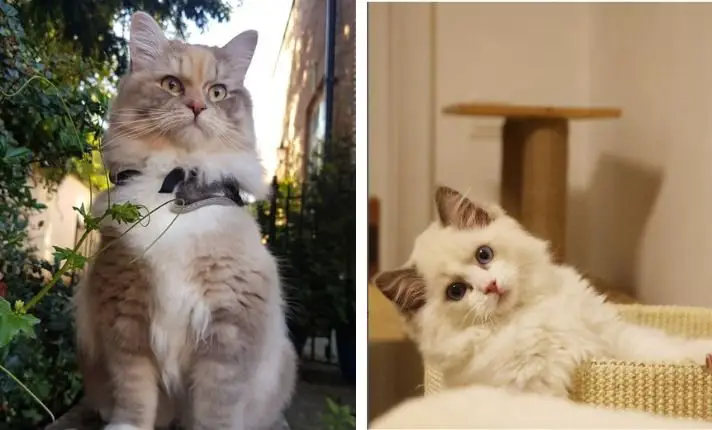
Physical Differences
Although they look quite similar, both Ragdoll and ragamuffin cat have some key differences:
Size and Build
Both Ragamuffin and Ragdoll cats are known for their large size, often weighing between 10 to 20 pounds, with males typically being larger than females. However, Ragamuffins tend to be a bit stockier and more muscular, with a solid build and a broad chest, while Ragdolls have a longer, more streamlined body. The Ragamuffin’s size can be deceptive as they often feel heavier than they look due to their dense, muscular frame.
Coat and Colors
While both breeds have long, luxurious coats, there are differences in texture and color. Ragdolls often have a silky, plush coat that requires moderate grooming, and they are best known for their pointed color patterns on the face, ears, paws, and tail. The most common Ragdoll color patterns include colorpoint, mitted, and bicolor, with colors such as seal, blue, chocolate, and lilac.
Ragamuffins, on the other hand, have a thicker, softer coat that comes in a wider range of colors and patterns, including solid, tortoiseshell, tabby, and mink. Ragamuffins can be found in virtually any color or pattern, which adds to their visual appeal. Their coat is dense and plush, often compared to rabbit fur, and requires regular grooming to prevent matting.
Eye Color
One of the distinguishing features between the two breeds is the shape of their face and eyes. Ragdolls have a more defined muzzle with a moderately flat face and striking blue eyes, which is a defining trait of the breed.
Ragamuffins have a more rounded face, and their eyes are large, walnut-shaped, and can come in any color including blue, green, gold, or even odd-eyed (two different colored eyes).
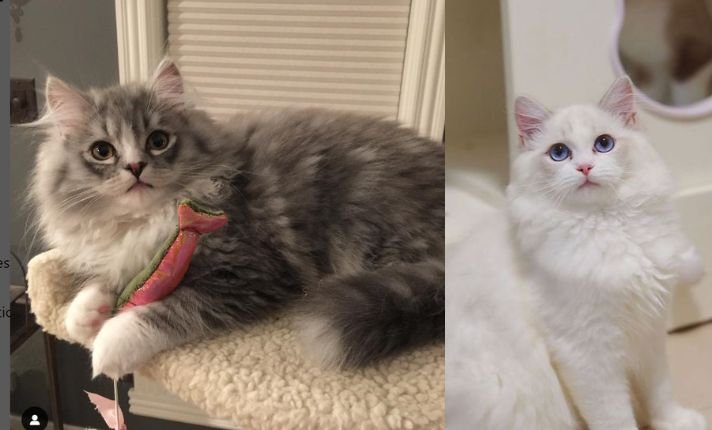
Temperament & Personality
Temperament Similarities: Both Ragamuffin and Ragdoll cats are known for their affectionate, easygoing nature, which makes them excellent companions for families, singles, and seniors alike. They thrive on human interaction and love being the center of attention. Both breeds are often described as “puppy-like” due to their tendency to follow their owners from room to room and their willingness to be held and cuddled.
Ragdolls
Ragdolls are famous for their laid-back demeanor. They are incredibly docile and tend to go limp when picked up, earning them their name. This “floppy” behavior is unique to the breed and is often a reason people fall in love with them.
Ragdolls are highly people-oriented and tend to form strong bonds with their human families. They are typically quiet cats that enjoy lounging in cozy spots, and they are also known for being non-aggressive. Ragdolls are great for households that prefer a relaxed and low-energy pet that will spend time cuddling and sleeping beside their owners.
Ragdolls are often compared to dogs in terms of their loyalty and attachment to their owners. They may greet you at the door, follow you from room to room, and even learn simple tricks like “fetch.” While they are generally low-energy, they do enjoy interactive play, especially with wand toys or softballs. However, their energy needs are moderate, and they are just as happy to nap as they are to engage in playtime.
Ragamuffins
Ragamuffins share the loving nature of Ragdolls but are often described as being more playful and outgoing. They are curious cats that love exploring their surroundings and engaging in interactive play.
Ragamuffins are highly adaptable and can adjust well to new environments, making them an excellent choice for households with children, other pets, or frequent visitors. Their friendly and social demeanor means they are less likely to hide when guests arrive and more likely to greet them warmly.
Ragamuffins are also known for their intelligence and can be trained to perform tricks, walk on a leash, or play fetch. Their playful nature often persists well into adulthood, which makes them entertaining companions. Many owners describe them as “puppy-like” because they are so eager to follow their humans around the house and be involved in whatever activity is taking place.
Ragamuffins are also vocal, using a range of meows, trills, and purrs to communicate with their owners, which can be quite charming.
Unlike Ragdolls, who tend to be more passive, Ragamuffins have a greater desire for play and mental stimulation. They enjoy puzzle toys and interactive games that challenge their minds.
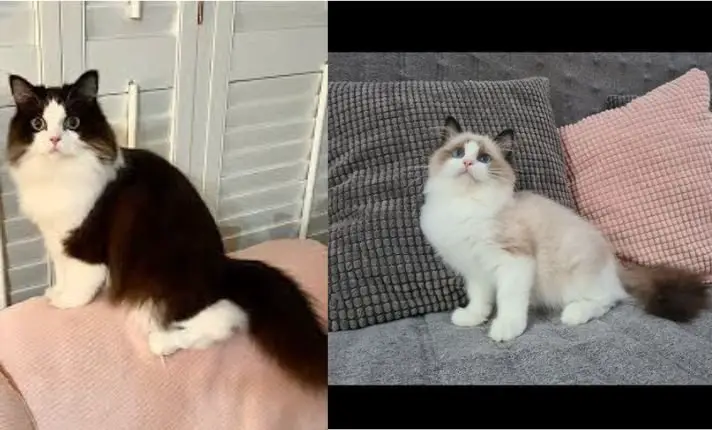
Health and Lifespan
Both breeds are usually healthy. But like all purebred cats, they might be more likely to have certain inherited health issues, including:
Ragdoll
Ragdolls are generally healthy, but they can be prone to hypertrophic cardiomyopathy (HCM), a common heart condition in cats that causes the heart walls to thicken, leading to reduced heart function. Regular veterinary check-ups and screening for HCM are important for maintaining the health of Ragdolls. Ragdolls have a lifespan of around 12 to 15 years.
Ragamuffin
Ragamuffins can also be prone to hypertrophic cardiomyopathy, as well as polycystic kidney disease (PKD), a condition that causes the development of fluid-filled cysts in the kidneys. Regular vet visits and proper care are essential to help prevent or manage these conditions. With proper care, both breeds have a lifespan of around 12 to 18 years.
Grooming and Care Requirements
Coat Maintenance: Grooming needs differ between the two breeds. Ragamuffins generally require more frequent brushing due to their thicker coats. Their dense fur is prone to matting if not groomed regularly, so brushing two to three times a week is recommended to keep their coats in good condition.
In contrast, Ragdolls have a silkier coat that is less likely to mat, but they still benefit from weekly brushing to minimize shedding and prevent tangles. Regular grooming also helps to strengthen the bond between you and your cat.
Health Considerations: Both breeds are generally healthy but can be prone to specific health issues. Ragdolls are at risk for hypertrophic cardiomyopathy (HCM), a genetic heart condition that is common in many cat breeds. Responsible breeders often screen for HCM to reduce the risk of passing it on to future generations.
Ragamuffins can also be susceptible to HCM, as well as polycystic kidney disease (PKD), a condition that affects the kidneys. Regular vet check-ups, a balanced diet, and an active lifestyle are important for maintaining the overall health of both breeds.
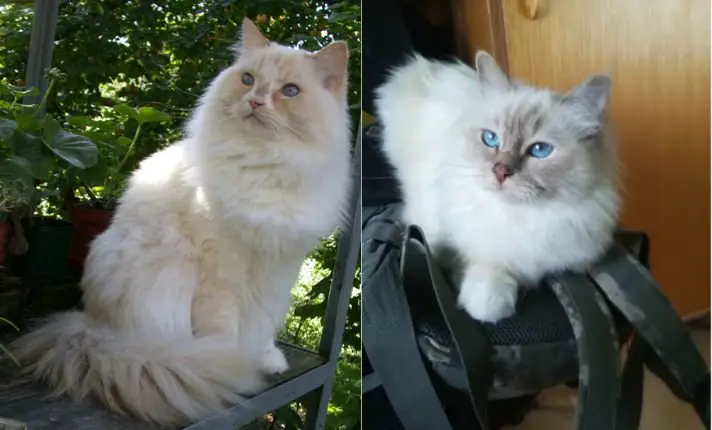
Which Breed is Best for You: Ragdoll vs Ragamuffin Cat?
Choosing between a Ragamuffin and a Ragdoll ultimately comes down to your lifestyle and preferences. If you prefer a calm, cuddly cat that is content to lounge around and keep you company, a Ragdoll may be the best fit. Ragdolls are perfect for those who want a relaxed, affectionate cat that enjoys being held and cuddled. If you want a more playful, adaptable cat that enjoys interaction, exploring, and engaging with family activities, a Ragamuffin might be the better choice.
Decision-Making Tips: Before making a decision, consider visiting breeders or adoption centers to spend time with both breeds. This will help you get a better understanding of their personalities and determine which breed feels like the best fit for your family. It’s also important to consider the grooming requirements and energy levels of each breed to ensure you can meet their needs.
Cost and Availability
When considering the cost, both Ragamuffin and Ragdoll kittens are relatively expensive due to their popularity. Ragdoll kittens typically range from $800 to $2,500 depending on their lineage, markings, and characteristics, while Ragamuffins can range from $1,000 to $3,000. The price of a kitten may also vary based on the breeder’s reputation and the cat’s pedigree.
Availability: Ragdolls are more well-known and thus are easier to find from breeders. Ragamuffins are slightly less common, and finding a reputable breeder may take more time. When looking for a kitten, it’s important to choose a breeder who follows ethical breeding practices and provides health guarantees for their cats. A
doption is also an option, although both breeds are relatively rare in shelters. Adopting an adult cat can be a wonderful alternative for those looking for a loving companion.
Frequently Asked Questions (FAQs)
Q1. Which is more affectionate: Ragamuffin or Ragdoll?
A. Both breeds are incredibly affectionate, but Ragdolls are known for their “floppy” behavior and love of cuddling, while Ragamuffins are also loving but may be a bit more playful and engaging.
Q2. Are Ragamuffins and Ragdolls good for families with children?
A. Yes, both breeds are excellent choices for families with children due to their gentle and affectionate nature. Ragamuffins tend to be more playful, while Ragdolls are calm and patient, making them suitable for homes with young children.
Q3. How do you know if your cat is a Ragdoll?
A. Ragdolls have blue eyes, large paws, long fluffy tails, and soft, semi-long coats. They usually have white fur with darker spots on their ears, face, tail, and paws.
Conclusion
Ragamuffin and Ragdoll cats are both loving, gentle companions, but they each bring their own unique traits to the table. While Ragamuffins are more playful, energetic, and adaptable, Ragdolls are known for their calm and docile nature, perfect for those who enjoy a relaxed feline friend.
By understanding the key differences between these two breeds, you can make an informed decision and choose the perfect feline friend for your home. Whether you decide on a Ragamuffin or a Ragdoll, you’re sure to have a loyal and affectionate companion by your side.

Hey guys, My name is Simon Smith. I’m from Canada and live near Victoria
I live with my sweet family and have 20+ Ragdolls of different types. I love them as my children. My profession is as a hotel manager.
I love to keep Ragdolls and grow their breeder case. I have 7 years of experience.
I’m an expert in cat care. So, I’m here to provide you with new information about my cats daily. This is my blog website, so I request that you kindly visit our site daily.
If you’re a Ragdolls lover and you have any questions or confusion about cats, text me on the Contact Us page or Gmail.
Thank u
